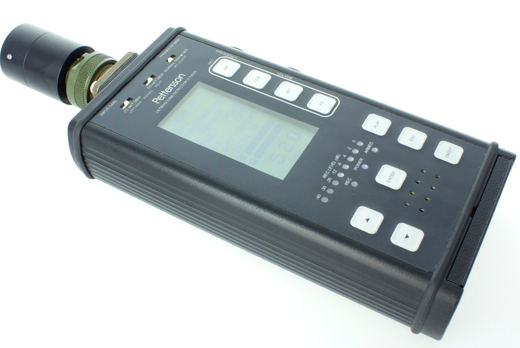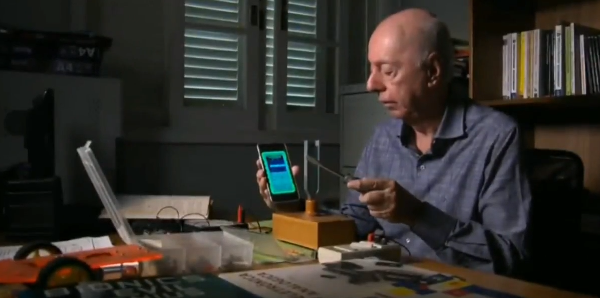
In fact, the idea of ??sonic weapons or acoustic weapons which could be used in attacks like the one that took place in the American Embassy in Cuba is not new.
We can say that using sounds or mechanical vibrations of material means (as defined by physics) is already something explored millions of years ago by nature.
The fact is that by carrying energy, the acoustic waves which we will explain in details later, have a destructive power.
Thus, we can start with the interesting case of the "pistol shrimp" or "snap shrimp" that produces a sonic shock wave capable of stunning their prey or enemies, thus enabling the attack.
This small animal has an organ which produces an acoustic shock wave that spreads in the water. This propagation is facilitated by the fact that in liquid means the velocity of sound is higher than in the air (340 m/s) according to the table below.
| Liquid | Temperature (°C) | Speed (m/s) |
| Acetone | 20 | 1 192 |
| Benzene | 20 | 1 326 |
| Ethyl alcohol | 20 | 1 180 |
| Glycerin | 20 | 1 923 |
| Mercury | 20 | 1 451 |
| Methyl alcohol | 20 | 1 123 |
| Common water | 25 | 1 497 |
| Se water | 17 | 1 510 a 1550 (*) |
| Heavy water | 25 | 1 399 |
| Gasoline | 34 | 1 250 |
(*) It depends on the density, varying from location to location
An interesting video on Yutube showing the "shooting" effect that the animal produces can be watched on the link: https://www.youtube.com/watch?v=02m9EXbwKMU
But how is all this possible? Why does sound have destructive effects? What are the effects on the human body?
This is what we will see.
The Nature of Sound
Although in our books "Basic Electronic Course" and "Sound Course" (Only in Portuguese ) the reader can find more technical explanations, we will try to be more didactic so that even the "non-electronic" ones can understand.
Sound waves are mechanical vibrations needing to propagate through material means. In the void the sound does not propagate.
On the moon a conversation would be impossible, since it has no atmosphere and the "sounds of explosion" in the space we see in fiction films consist of an aberration, because everything is silent there. In the air, the sound propagates in the form of compression and decompression waves, as shown in Figure 1.
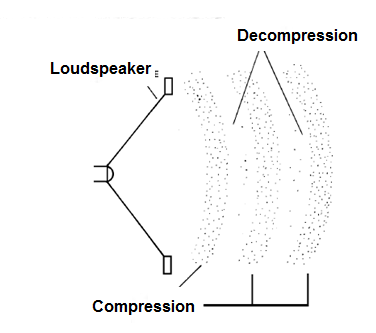
Thus, a loudspeaker, when reproducing a sound, pushes the air forward to produce a compression wave and then, when moving in the opposite direction, pulls it to produce a wave of decompression. Both the compression and decompression propagate at the same speed which, in the air under normal temperature and pressure conditions, is about 340 meters per second.
When these waves of compression and decompression reach our ears, they act on a thin membrane in the interior, called the eardrum, which transmits the vibrations to the internal system. The inner mechanical system of our ears, made of some very delicate moving bones, "translates" the information about the nature of the sound picked up and sends it to the brain through nerve connections. In Figure 2 we have a cross-sectional view of our ear.
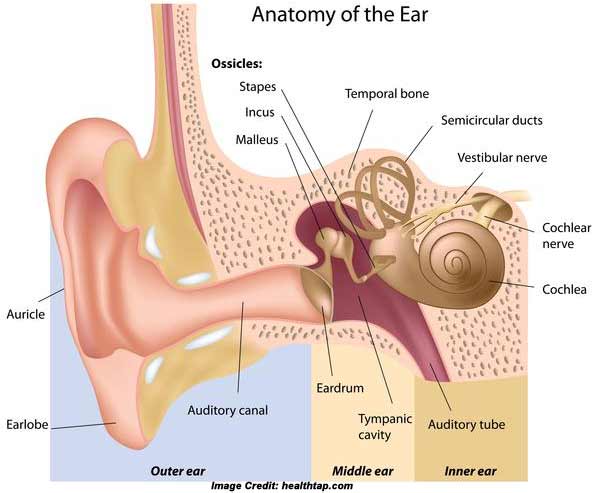
Audible Spectrum
There is a well-defined limit to the kind of sound vibrations our ears can “notice”. So we initially have a lower limit for the frequencies of vibrations which determines our hearing range and that is around 16 to 20 hertz or 16 to 20 vibrations per second.
This limit corresponds to the lowest sounds we can hear. We can not hear vibrations which happen slower than at the rate of 16 hertz per second.
As the frequency of sounds or vibrations increase, they produce different sensations. Initially low, they become medium and then high until the maximum value that we can perceive is reached. For ordinary people the amount varies a bit but it is around 16 000 hertz for most people.
This frequency corresponds to the highest sound that most people can hear. See Figure 3 where we show a graph which represents the audible range, that is, where the sounds of all the frequencies that we can hear are.

Below the lower limit we have the range of infrasounds and above the upper limit of hearing we have the vibrations called ultrasounds. There are animals like the bat, the dolphin and even the dog that have an upper limit of hearing above ours. These animals can hear ultrasounds of frequencies that in some cases reach 100 000 Hz or 100 kHz!
The audible range can be considered valid for the average person. In addition to changing from person to person, it also changes within age. As we get older, our hearing range narrows and we stop hearing the higher frequencies and even the lower frequencies.
Sound Features
a) Pitch
The pitch is the characteristic of a sound that is linked to its frequency. We say that one sound has a higher pitch than another when its frequency is greater.
The sounds of lower frequencies are called low pitch or high, then we have the middle ones and finally the high pitch or just high. A higher sound is therefore a sharper sound. For the musical instruments we can say that the sound of the violin is higher than the sound of the guitar.
We should not confuse the pitch of a sound with its intensity or loudness which we explain below.
b) Loudness or Intensity
Loudness or intensity is the characteristic of the sound attached to the force with which the compression and decompression waves occur. The loudness or intensity is associated with the sound power.
Two amplifiers which have different powers, when connected to the maximum volume, produce sounds with different loudness or intensities. The representation of two sounds with the same frequency at different intensities is done as the reader can see in Figure 4.
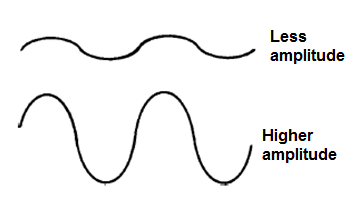
See that they are represented by "ripples" or waves which indicate the points of greater and lesser compression, that is, the "peaks" and "valleys".
This representation is used with other types of "vibrations", for example, radio waves, light, etc.
We remember that sound waves carry energy and that energy can have destructive effects. Thus, the sound heard at great intensity, as occurs in many nightclubs, shows ,even by those who wear headphones, can cause hearing problems such as a decrease in hearing capacity and even complete deafness.
High-intensity waves are used in cleaning tools and equipment. Its energy, for example, can be used to clean metal objects (jewelry, for example) in ultrasonic cleaners, as shown in Figure 5.

And in our case, this energy has the destructive and is dangerous for living organisms, as we will show now.
Effects on the human body
A first effect we can mention is precisely what occurs with the audible sounds acting on our ears.
For greater ease of representation of the sonorous intensities and even of its calculations a logarithmic unit called Bel is adopted. What is done then is to adopt for the measurement of the sound intensity a logarithmic unit.
This unit is Bel, and in practice we work with tenths of bel or decibels, abbreviated by dB. See Figure 6 for the sensitivity of the human ear for the sounds of various frequencies on a scale in dB.
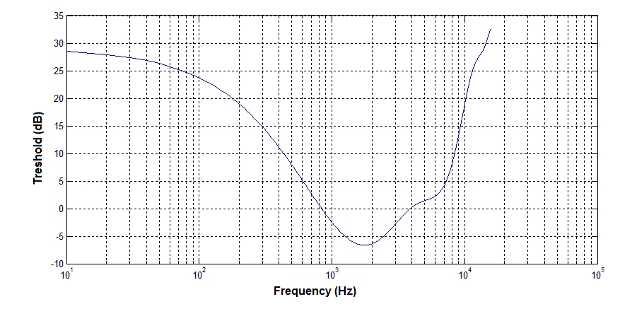
The table below shows the relative sound levels in dB of some common sources, so the reader has an idea of ??how this scale works.
| Sound Source | Sound level |
| Normal breathing | 10 dB |
| Silent sleeping room | 35 dB |
| Normal voice conversation | 45 dB |
| People speaking loudly | 60 dB |
| Noisy party | 90 dB |
| Busy street | 90 dB |
| Rock Concert | 120 dB |
| Thunder | 120 dB |
| Jet taking off (30 m away) | 140 dB |
Our ears can have irreversible damage from being subjected to intense sounds. Thus, the higher the sound intensity, the greater the short-term damage.
An interesting survey by the government of a European country a few years ago showed in the young people’s hearing exam to serve the army, a good many of them had irreversibly compromised their hearing by constantly hearing sound on the high volume in their sound equipment and in their houses at night.
But the danger goes beyond that.
Sonic Weapons and Attacks
As we explain, the sound waves carry energy. The more energy, the greater its intensity. But in addition, a frequency can influence how sound acts on living organisms.
In 1992 we published in a technical magazine an interesting project of a "panic circuit" (*) which combined sounds and ultrasound in order to disturb people. This project was published in our book "Bionics for the Evil Genius" in the United States in 2006 and translated into Chinese in 2007.
(*) http://newtoncbraga.com/index.php/articles/79-bionics-and-medicine/457-panic-generator-bm004

Figure 7 - Books in English and Chinese in which the project was published
Although the project was only experimental, the subject ended up being reflected in several places, and even in the American series "Myth Busters" there was an episode recorded about this subject.
The basic idea of the researchers is that the low frequency noises (infrasounds) in great intensity would be felt more clearly by the stomach and intestines causing discomfort and nausea and in extreme cases even cause the lack of control in the intestines.
At the time the term "brown noise," in allusion to the color of feces, was used to designate low frequency noises (infrasounds) capable of having effects on the human organism.
In our story "The Dysenteric Oscillator" we explored the subject with our hero Prof. Ventura, creating an oscillator capable of generating ultrasounds and infrasounds to scare birds, that ended up affecting the entire city with intestinal lack of control. See the story on the link:

Based on the real effects, even if controversial, it did not allow people to think about the use of sounds, ultrasounds and infrasounds as weapons and this has been coming for some years.
The Americans themselves have created sonic weapons and devices capable of producing interesting effects on people.
One of them, already used in a practical way, is an emitter used in demonstrations that causes discomfort in the crowd, discouraging them to proceed.
In the photo the American police used a sonic weapon to disperse protesters in a protest in Pittsburgh.

Figure 9 - real sonic weapons
An interesting feature that can be used at certain times for attacks or even defense features is precisely the fact that people have different hearing abilities as far as the spectrum they can hear.
Young people can hear higher frequencies than adults and older people.
For an adult, it is common for their hearing not to exceed 10 000 or 12 000 Hz, reaching in some cases 13 000 Hz. However, young people can hear 15 000 and even sounds of higher frequencies, being common those that reach 18 000 Hz.
Using an application from our cell phone and explaining how to use it in another article, we teach you how to determine your own he aring range.
The fact is that taking into account that a frequency of 14 000 Hz will be heard by most young people, but not by adults, a mall in the United States used a powerful oscillator at this frequency to "bother" and discourage the young "messes" that bothered much more than to torment people who buy anything.
Powerful ultrasonic emitters are used near airports to chase birds that could enter the turbine of a plane causing disaster and crops and silos to chase away birds and small rodents.
Of course, the effects can be even greater with the destruction of walls and other targets.
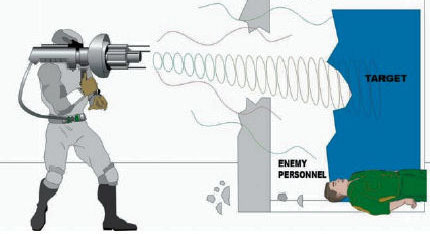
Figure 10 - A sonic weapon of destruction
The above illustration shows what a powerful sonic weapon would be, though we still have no news if it would be real.
Resonance and Brontophonic sound
Structures, depending on their shape, dimensions and the material from which they are made, tend to vibrate at a given frequency.
That is why, when we hit a small metal bar and a large bar, the sounds produced have different frequencies. Each bar tends to vibrate at its own frequency, as the reader can see from Figure 11.

Figure 11 - Bars of different lengths vibrate at different frequencies
An instrument, of great utility for the tuning of musical instruments, that is based totally on the resonance, is the tuning fork. As can be seen from Figure 12, it consists of a fork-shaped metal bar which, when energized (beating or bending) produces a sound at a fixed frequency, usually the 440 Hz Hertz note on which a large amount of musical instruments rely on.

Figure 12 - A tuning fork in a wooden box, like those used in physics labs - The author used one on his demonstration on the “Fantastico” program
Resonance may be a desired or undesired phenomenon in many applications involving sounds. It is desired when we need to produce a fixed frequency sound and we can take advantage of the physical characteristics of an object.
The musical instruments are based entirely on this.
It is unwanted when a presence of stronger vibrations in the frequency at which a body tends to vibrate brings some kind of problem.
A glass which vibrates by the voice of a soprano entering resonance can shatter. A building which starts to vibrate at a resonant frequency may collapse.
The name Brontophonic for certain types of sounds comes from the Latin meaning "thunder". This term describes a kind of sound which drives the objects causing them to vibrate at a different frequency. It is the sound produced by the glass of a window that vibrates with the low-frequency waves from a thunder. This type of sound can be used in sonic attacks, although little has been published about it..
And what has happened in Cuba?
The first important fact for the development of events when analyzing what has happened in Cuba is that infrasounds and ultrasounds can affect the human body causing irreversible damages when applied in great intensity, as well as discomfort such as nausea, headaches, dizziness and even bowel uncontrol.
The second fact is that a powerful source which directs the vibrations to an embassy or to employees' homes would not be noticed. Only their effects would appear after some time without the people being able to realize their origin.
It was probably what happened.
Powerful sources of ultrasounds or infrasounds (or both) would have been responsible for the effects on employees who noticed something abnormal when they manifested.
Is there a way to get protected?
What exists is the possibility of detecting these vibrations.
Sensors which use microphones that reach a range of infrasound and ultrasound would easily indicate the presence of vibrations in an environment. They are simple to assemble and there are even types of ready-to-sell.
We do not understand how, an embassy in a critical place like Cuba, and that usually make use of more advanced electronic devices like detectors of spy transmitters, locators, etc. is not preventive with a simple sonic detector.
In the photo, an example of a commercial ultrasound detector reaches from 5 kHz to 235 kHz.
